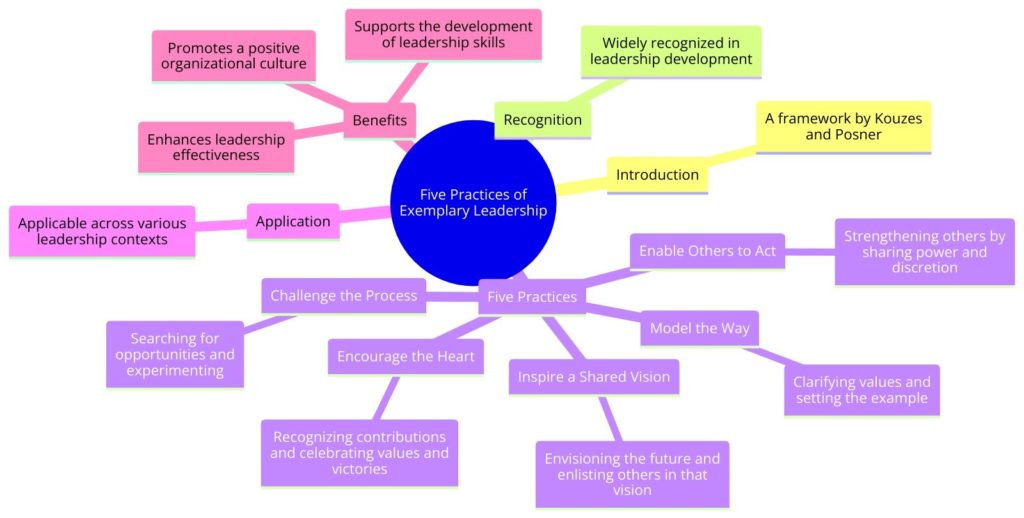Five Practices of Exemplary Leadership
Kouzes and Posner’s Five Practices of Exemplary Leadership is a widely recognized framework in the field of leadership development. Introduced by James M. Kouzes and Barry Z. Posner in their book “The Leadership Challenge,” first published in 1987, the framework is based on research that began in the early 1980s. Kouzes and Posner identified five core practices common to high-performing leaders after analyzing thousands of case studies and survey questionnaires. These practices are designed to help leaders understand and apply behaviors that foster an environment of achievement, innovation, and collaboration.
The Five Practices of Exemplary Leadership
- Model the Way: Leaders establish principles concerning the way people should be treated and the way goals should be pursued. They create standards of excellence and then set an example for others to follow. This practice is about being clear about one’s personal values and beliefs and demonstrating those values through actions.
- Inspire a Shared Vision: Leaders envision the future by imagining exciting and ennobling possibilities. They enlist others in a common vision by appealing to shared aspirations. This involves communicating a compelling vision of the future in a way that inspires others to act.
- Challenge the Process: Leaders search for opportunities to change the status quo. They look for innovative ways to improve the organization and are not afraid to experiment and take risks, even if there is a chance of failure. This practice is about fostering a culture of innovation and courage.
- Enable Others to Act: Leaders foster collaboration and build spirited teams. They actively involve others, strengthen others’ ability to excel through empowerment, and create an atmosphere of trust and human dignity. This practice emphasizes the importance of mutual respect and the power of collaboration.
- Encourage the Heart: Recognizing contributions and celebrating accomplishments are key components of this practice. Leaders show appreciation for individual excellence and create a culture of celebration. Encouragement and positive feedback are used to motivate team members and build community.
Why It Is Valuable
Kouzes and Posner’s framework is invaluable for several reasons:
- Universality: The Five Practices are applicable across cultures, industries, and organizational types, making the framework versatile and widely relevant.
- Action-Oriented: Each practice is associated with actionable behaviors that leaders can develop and strengthen over time.
- Empirical Support: The practices are grounded in research and have been validated through studies, reinforcing their effectiveness.
- Focus on Development: The framework emphasizes that leadership is a set of behaviors that can be learned and mastered by anyone, encouraging ongoing personal and professional development.
When and How to Use It
Leaders and aspiring leaders can use the Five Practices as a guide for personal development, team building, and organizational leadership. Implementing the practices involves:
- Self-assessment and reflection to understand one’s current behaviors and areas for improvement.
- Setting specific, actionable goals related to each of the five practices.
- Seeking feedback from peers, mentors, and team members on leadership behavior.
- Continually practicing and refining leadership behaviors in line with the Five Practices.
Shortcomings/Criticisms
While Kouzes and Posner’s model is highly regarded, it is not without its criticisms:
- Complexity in Application: Some may find it challenging to simultaneously focus on and balance all five practices effectively.
- Lack of Emphasis on Context: Critics argue that the model could better address how different situations might require different approaches or how cultural differences can impact the application of the practices.
- Perceived Idealism: Some view the framework as overly idealistic, potentially overlooking the pragmatic and sometimes harsh realities of organizational life.
Kouzes and Posner’s Five Practices of Exemplary Leadership provide a robust and comprehensive framework for understanding and applying effective leadership behaviors. By focusing on these core practices, leaders can inspire and enable others to achieve extraordinary things, fostering environments where innovation, collaboration, and achievement thrive. Despite some criticisms, the framework’s emphasis on actionable behaviors and its broad applicability make it a valuable resource for leaders across all levels and contexts.


